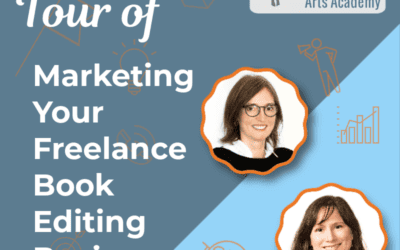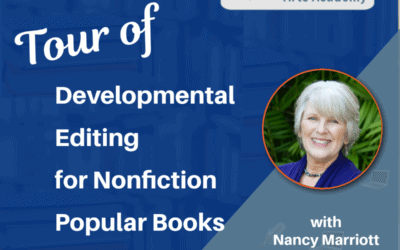Editor’s note: This is a guest post by editorial professional Nancy Marriott.
In my 25+ years of freelance book editing, I’ve come across some difficult clients. From my experience with authors of nonfiction popular books, I’ve learned a few things.
Not to pigeonhole, but I have noticed some patterns. Difficult clients tend to fall into one or more of the following categories:
- Bulldozers
- Runaway Scatterbrains
- Disappearing Dilly-dalliers
- Just-One-More-Thingers

Nonfiction Author Type #1: Bulldozer
Bulldozers will tend to roll right over you with their ideas, demands, and questions, requiring you to have firm boundaries and the guts to interrupt them. Many of my nonfiction authors—lawyers, doctors, businesspeople—are used to calling the shots. They’re the Tony Robbins types, pumped and fixed on a goal high in the stars, and they’ve been coached not to veer from that path to bestselling glory.
But there’s ways to get them to listen to you instead of the other way around. Your listening is important to convey, but there comes the point when it’s the client’s turn to listen, so you’ll need to politely interrupt them.
Here’s some “interrupters” that have worked for me:
- “Excuse me, can I offer something here?”
- Or even more authoritatively: “I’m sorry, but I need you to slow down and give me a chance to respond.”
- Or if confused or lost in the ramble, “Excuse me, but I’m not sure I’m following you. Can I ask you a question?”
In the latter, you can offer to paraphrase what they’ve been saying: “I think what you’re saying is …”
Bulldozers love to know you’ve actually heard them—in fact, it could be their fear that you didn’t that drives their engines!
Nonfiction Author Type #2: Runaway Scatterbrains
Runaway scatterbrains are the opposite of bulldozers: they’re uncertain about what to do, especially when hearing from you that their manuscript “needs work.” Although they might agree with your directions, they don’t know how to carry them out, and so they bounce around in the various directions you’ve given them, not really grasping any. Were your directions too obtuse? Not always.
In these cases, you must take the lead. Chances are they haven’t clarified something very basic about their book, like its main theme or voice. This is often the result of too much input from others who’ve read their manuscript and given conflicting feedback.
One of my clients was stopped by needing to decide about her author voice. She had two distinct voices going on in her manuscript—both a practical teacher voice and a poetic inspirational voice. Her first dilemma was which one to use. Her second dilemma was how to include both voices. And then she wondered where to use each. I listened patiently, and then I heard it: the one voice she wanted to use, that she felt most comfortable with. A new version that included both had that “ring,” and I told her so. “I’ve been listening to you sort through all the possibilities, but the one you just spoke is ringing most true for me.” She let out a sigh of relief, and we moved on.
So often, editors will let their clients ramble on in their confusion, hoping the confusion will dissipate and the author will soon finish. But by actively listening for what makes the author soar, makes their heart sing, you help them find what inspires them to go on.
It can certainly be a challenge to work on a memoir with a runaway scatterbrain author, as they must confront material they may not be ready to process. I’ve had to tell a few of my memoir-writing clients to go back to the drawing board on a particular scene or issue, urging them to do the personal work that will bring greater clarity.
Nonfiction Author Type #3: Disappearing Dillydalliers
Disappearing dillydalliers aren’t really serious about doing the work, and so they bob up and down in their interests, motivation, and appearance. In and out! I’ve found this type often disappearing halfway through the project. That’s okay; there’s no judgment here. But, as an editor, you don’t want to take their lack of commitment personally. It’s not your fault!
And you want to protect yourself with a letter of agreement (LOA, aka contract) that puts a time limit on your work together and when you will be paid. If you don’t do this, you might find a long-ago client at your doorstep expecting services for a project you can barely remember.
In my LOA, I’ve learned to include beginning and ending dates for the fees paid, adjustable according to the particular project. You can insert this clause:
Timeline: Beginning (date), Editor will provide services until ending of the X-month editing period, or (date); if project is not completed by that time, a new fee structure will need to be negotiated.
Nonfiction Author Type #4: Just-One-More-Thingers
Then there’s the just-one-more-thingers. These clients want to make multiple or big changes once the manuscript has reached the final draft and your services are complete.
For example, one client wanted to run her completed and fully edited manuscript by her marketing team “before I submit it.” She was under contract with a traditional publisher and had received a sizable advance.
I slept on the request. (Word to the wise: Never fire off a response to a disturbing request, as I almost did, feeling insulted she wasn’t trusting my final edit.) The next day, bruised ego aside, but concerned about doing extra work for no pay, I wrote back, saying essentially, “Okay, go ahead, but if there’s added text as a result of new input, I won’t be editing it without charging an additional fee.” She agreed, but then it turned out she didn’t have time to consult with her marketing department and still meet her publisher’s deadline. The manuscript was submitted with no additional text or editing.
Achieving the Optimal Author-Editor Relationship
There are probably more types of difficult clients than those I’ve described here, and some that may not fit into any category neatly. The important thing to always keep in mind is that it’s their book, not yours, and so your job is to provide the support they need for achieving the outcome they desire, as tactfully but effectively as possible! This is especially true when you’re dealing with nonfiction authors and their how-to, self-help, and prescriptive nonfiction books, or memoirs written in the style of narrative nonfiction. The challenges for these authors will be different than for fiction authors, and so they may require new interpersonal skill to navigate. Recognizing the type of author you’re dealing with beforehand can prevent you from being be blindsided and thus smooth the way for an optimal author-editor relationship.
There’s a lot that goes into a working relationship between an editor and nonfiction author, from big-picture guidance to line-by-line wordsmithing, and even assistance with book proposals. Are you interested in learning how I work with authors to create their nonfiction book? Check out my class, Developmental Editing for Nonfiction Popular Books.



